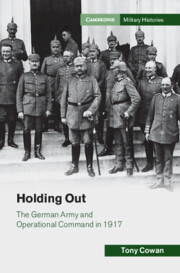Book contents
- Holding Out
- Cambridge Military Histories
- Holding Out
- Copyright page
- Dedication
- Contents
- Figures
- Maps
- Tables
- Acknowledgements
- Comparative Ranks
- Chronology
- Abbreviations
- General key to maps
- Introduction
- 1 Context
- 2 Principles
- 3 Organisation
- 4 Personality
- 5 Intelligence
- 6 Communication
- 7 Learning
- 8 Performance
- Conclusion
- Bibliography
- Index
- Holding Out
- Cambridge Military Histories
- Holding Out
- Copyright page
- Dedication
- Contents
- Figures
- Maps
- Tables
- Acknowledgements
- Comparative Ranks
- Chronology
- Abbreviations
- General key to maps
- Introduction
- 1 Context
- 2 Principles
- 3 Organisation
- 4 Personality
- 5 Intelligence
- 6 Communication
- 7 Learning
- 8 Performance
- Conclusion
- Bibliography
- Index
Summary
Recaps why 1917 Entente spring offensive a good case study of German command, and derivation of the command tasks. Sums up findings on the patchy fulfilment of the tasks. Shows why they apply to German command throughout the First World War and beyond; draws parallels with British and French experience.
The German army which emerges was neither a picture of military excellence nor a gang of incompetents. Analysing its command tasks and their fulfilment produces a more rounded and more humanly recognisable picture of German command and of the army as an institution. This helps understand better their contribution to Germany’s ability to hold out for four years. In early 1917, the army was flawed and under increasing strain, but still able to think and operate effectively. It remained too formidable an opponent for the Entente to defeat despite their numerical and material superiority.
Keywords
- Type
- Chapter
- Information
- Holding OutThe German Army and Operational Command in 1917, pp. 276 - 285Publisher: Cambridge University PressPrint publication year: 2023

